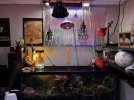I am very happy to find this forum. I have much distaste for the infinite echo chamber that is Reddit 
I've joined up to see what thoughts/opinions you guys may have on my lighting setup for a crested gecko.
I have been building a truly bioactive terrarium for the past several months. I'd be happy to share more about this if there are questions, it's just not relevant to the questions I have at the moment. But the TLDR; as far as microfauna and insects go, I have about a pound of red wrigglers and european night crawlers, a 1/4 pound of canadians, about 1000 isopods of various powder colors and dairy cows, about 500 tropical white springtails, about 200 orange springtails, about 100 "Florida orange" springtails. These were all well established over the course of time before investing in a larger animal. Potentially going to add some millipedes over time.
I also have a bunch of feeder insects, crickets, dubias and bsf larva, these populations may or may not colonize, we'll see how it goes, hopefully I have put in enough and have been providing enough food to keep these colonies stable as well. The goal is to minimize these as inputs and allow them to breed along side everything else to some degree, but I don't want them to outcompete the cleanup crew above.
About 2 weeks ago I bought my first Crested Gecko (or really any reptile) ever. I had most of the lighting already as part of my horticultural adventures, but obviously a reptile may require a bit different light than just plants and buggers.
First some of the videos I've watched as part of researching the lighting, links to several of their sources in video descriptions:
Frances Baines, UV
Roman Muryn, Reptiles & Infrared
Thomas Griffiths, Reptile Lighting guide
Andrew Huberman, Using Light to Optimize Health
______________________________________________________________________
The lights I am currently using:
Basic Red 660nm lights:
Basic Orange lights 600nm? lights:
Red/Infrared Lights, 660nm/850nm:
Infrared Quartz Heat lights ~600nm-700nm/IR-A/IR-B:
Infrared Deep Heat Projector IR-B/IR-C
UVA Lights 385-400nm:
UVB Lights:
Grow Lights:
White Lights 5000k:
Bug Zapper & 5000k light (for fungus gnats):
2000k Edison:
2700k A19:
4000k Room Downlighting:

 store.waveformlighting.com
________________________________________________________________
store.waveformlighting.com
________________________________________________________________
Light Meters Used:
UVA/UVB Light Meter:
PAR MEter:
________________________________________________________________
A photo of my insane-in-the-membrane:
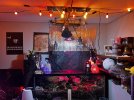
(several lights are off for the night already)
Some Readings:
UVI top of glass under UVB spot:
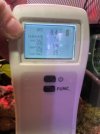
Same spot, Zoomed out
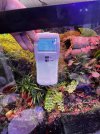
UVI same area, down a few inches:
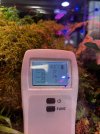
Readings are similar on the right side of the enclosure under the other UVB spot
A bit of PAR ground level:

PAR at higher point:

Requirements:
Am I doing this right?!?!
I've joined up to see what thoughts/opinions you guys may have on my lighting setup for a crested gecko.
I have been building a truly bioactive terrarium for the past several months. I'd be happy to share more about this if there are questions, it's just not relevant to the questions I have at the moment. But the TLDR; as far as microfauna and insects go, I have about a pound of red wrigglers and european night crawlers, a 1/4 pound of canadians, about 1000 isopods of various powder colors and dairy cows, about 500 tropical white springtails, about 200 orange springtails, about 100 "Florida orange" springtails. These were all well established over the course of time before investing in a larger animal. Potentially going to add some millipedes over time.
I also have a bunch of feeder insects, crickets, dubias and bsf larva, these populations may or may not colonize, we'll see how it goes, hopefully I have put in enough and have been providing enough food to keep these colonies stable as well. The goal is to minimize these as inputs and allow them to breed along side everything else to some degree, but I don't want them to outcompete the cleanup crew above.
About 2 weeks ago I bought my first Crested Gecko (or really any reptile) ever. I had most of the lighting already as part of my horticultural adventures, but obviously a reptile may require a bit different light than just plants and buggers.
First some of the videos I've watched as part of researching the lighting, links to several of their sources in video descriptions:
Frances Baines, UV
Roman Muryn, Reptiles & Infrared
Thomas Griffiths, Reptile Lighting guide
Andrew Huberman, Using Light to Optimize Health
The lights I am currently using:
Basic Red 660nm lights:
Basic Orange lights 600nm? lights:
Red/Infrared Lights, 660nm/850nm:
Infrared Quartz Heat lights ~600nm-700nm/IR-A/IR-B:
Infrared Deep Heat Projector IR-B/IR-C
UVA Lights 385-400nm:
UVB Lights:
Grow Lights:
White Lights 5000k:
Bug Zapper & 5000k light (for fungus gnats):
2000k Edison:
2700k A19:
4000k Room Downlighting:

PhotonTube™ T8 LED Grow Light Tube for Horticulture
Available in 4000K or 6500K to simulate natural sunlight 4-ft nominal length Full spectrum coverage from 420 nm to 800 nm with optimized spectra for plant growth 1.8 umols/J efficiency 33 umols/sec photon flux output Well suited for seedlings and vegetative growth 95 CRI and R9 > 80 Input...
 store.waveformlighting.com
store.waveformlighting.com
Light Meters Used:
UVA/UVB Light Meter:
PAR MEter:
________________________________________________________________
A photo of my insane-in-the-membrane:

(several lights are off for the night already)
Some Readings:
UVI top of glass under UVB spot:

Same spot, Zoomed out

UVI same area, down a few inches:

Readings are similar on the right side of the enclosure under the other UVB spot
A bit of PAR ground level:

PAR at higher point:

Requirements:
- Use LEDs wherever possible
- Temperature range throughout tank between 65F at night to 80F during the day with all lights on
- Temperature gradient left to right delta of no more than 10 degrees F
- Temperature gradient from top to bottom can exceed 10 degrees F, but no more than 15 degrees F
- Infrared and Red lighting is scientifically proven to increase health in plants, mammals and reptiles, lighting should "red shift" as much as possible.
- UVA light levels should exceed UVB light levels
- UVI should be no more than 1 at the top of the enclosure, goal of .5-.7
- PAR readings should exceed 25 umol/m2/s (~1500 LUX) at substrate layer and 60 umol/m2/s (~3000 LUX), at higher elevations providing adequate light for plants.
- Lights should be dimming and/or on individual timers.
- Room Lighting on at Sunrise
- All dimmable red/orange/white light starts at 15% at Sunrise, ramps on a schedule to 100% at noon, ramps down to 15% at 7:30 PM and turns off at 8 PM
- Non dimmable Infrared/Red turns on at 10:30AM and off at 7:00 PM
- Non dimmable white/UVA turns on at 10 AM and off at 3:30 PM
- UVB Spots, which are also a small amount of 6500k, turn on at Sunrise and off at 8 PM - trying to get some exposure to gecko since it's nocturnal I run this a bit later than the rest of lighting.
- DHP never turns off
Am I doing this right?!?!
Attachments
Last edited:
